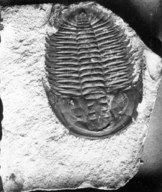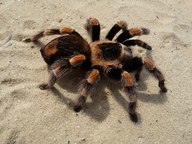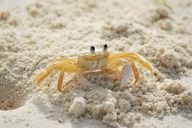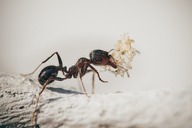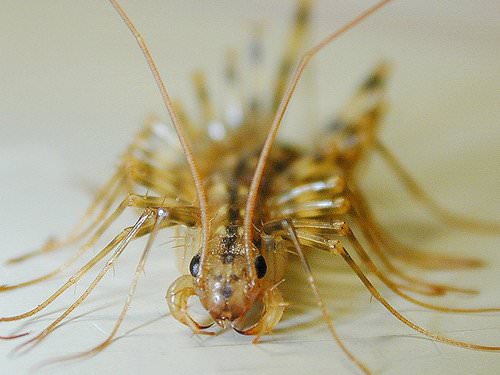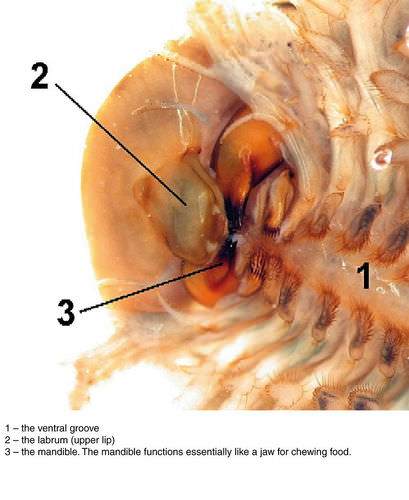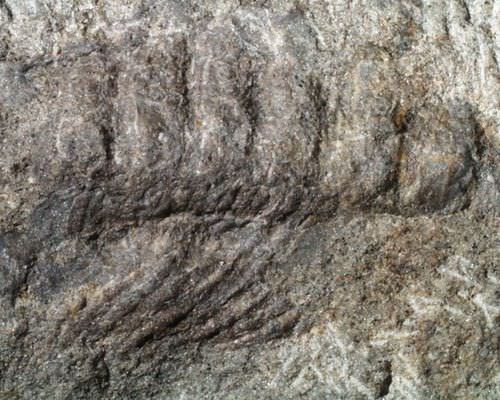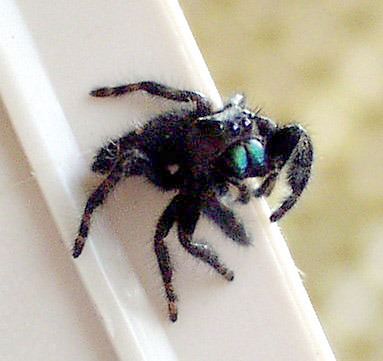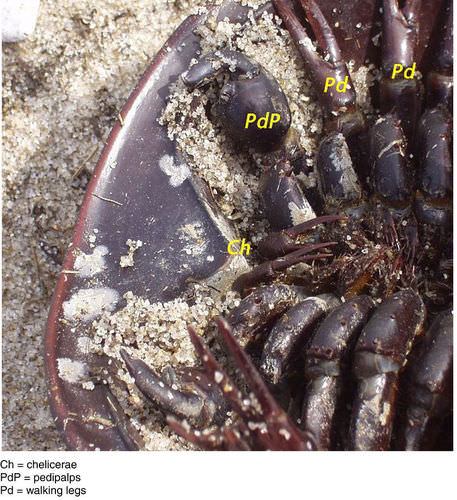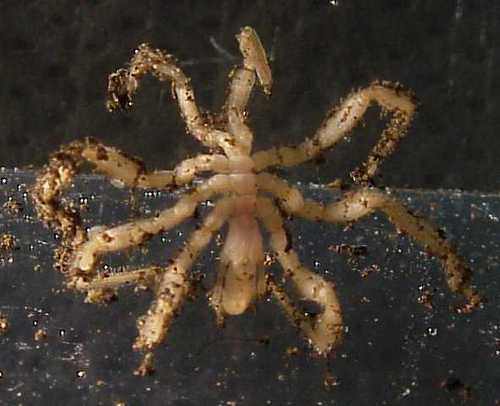15.33 Arthropod分类 -- -- 高级
章节大纲
-
How would you classify this ?
::你会怎么分类这个?This arthropod is a preying mantis. This mantis mimics leaves. Its coloration is an example of aggressive mimicry, a form of camouflage in which a predator's colors and patterns lure prey . It has numerous common names such as the Small Devil's Flower Mantis. Though a preying mantis may look scary, most of the 2,400 are less than 6 inches (15 cm) long, and some are even kept as pets.
::这种节肢动物是一种捕食性蚂蚁,它模仿了叶。它的颜色是攻击性模仿性模仿的一个例子,一种捕食者颜色和模式诱使猎物的伪装形式。它有许多共同的名称,比如小恶魔花瓣。 尽管猎食性蚂蚁可能看上去很可怕,但2,400只猎物中的大部分长不到6英寸(15厘米 ) , 有些甚至被作为宠物保存。Overview of Arthropod Classification
::亚热带动物分类概览Previously you learned that there are over one million arthropod species. How are the organisms within this diverse group related to each other? How are they subdivided into smaller groups based on shared characteristics and evolutionary history? As you will read, these questions are not always straightforward. Arthropods can be grouped into several subphyla, with each of these subphyla then divided into different classes. In this lesson we will examine how arthropods are divided into these subphyla, and then we will consider the details of one well-known subphylum: Crustacea. We will also take a look at one of the arthropod classes that contains many feared and reviled species: the .
::先前,你已经知道有超过100万个节肢动物物种。在这个不同的生物群中,生物体是如何互相关联的?它们是如何根据共同特征和进化史分成较小的组的?正如你将读到的那样,这些问题并非总能直截了当。这些亚节肢动物可以分为几个亚类,其中每种次类都分为不同的类别。在这个教训中,我们将研究节肢动物如何被划分为这些亚类,然后我们再研究一个众所周知的亚类:Crustacea。我们还将研究含有许多恐惧和被诅咒物种的节肢动物种类之一:The sheer number of arthropod species (over one million and growing!) presents a substantial challenge for scientists trying to subdivide them into distinct groups based on their evolutionary relatedness. Just to give you an idea of some of the conflicts that exist in the field of arthropod systematics, some scientists have suggested (based on molecular data) that some species within the group Crustacea are actually more closely related to (in the group Hexapoda) than they are to other crustacean species. This is currently a controversial topic, and in this lesson we will consider the established, traditional groupings of arthropods. In this , arthropods are divided into five subphyla:
::纯粹的节肢动物物种数量(超过100万种且正在增长! ) 给科学家们带来了巨大的挑战。 科学家们试图根据它们的进化关联性将其分解成不同的组别。 为了给你们了解在节肢动物系统领域存在的一些冲突,一些科学家(根据分子数据)指出,克鲁斯塔塞亚组中的某些物种实际上(在六甲波达组中)与其他甲壳类物种(在六甲波达组中)的关系更为密切。 目前,这是一个有争议的话题,在这个教训中,我们将考虑已确立的、传统的节肢动物组别。 在这一类中,节肢动物被分为五种亚植物:-
Trilobitomorpha (Trilobites).
::Trilobitoporma(三叶百叶百叶百叶百叶百叶百叶百叶百叶百叶百叶百叶百叶百叶百叶百叶百叶百叶百叶百叶百叶百叶百叶百叶百叶百叶百烯)。 -
Chelicerata.
::切丽斯特拉塔 -
Crustacea.
::克鲁斯塔西亚 -
Myriapoda.
::米里亚波达 -
Hexapoda
.
::六头蛇
The Subphyla and Classes Table lists the classes within each of these subphyla and shows an example of a typical member of each subphylum.
::子phyla 和 类表列出了这些子phyla 中每一类的类别,并展示了每个子phylum 中一个典型成员的例子。Subphyla and Classes of Arthropods Subphylum Class Examples Common members Trilobitomorpha Trilobites (extinct) - Extinct
Myriapoda - Chilopoda
- Diplopoda
- Pauropoda
- Symphyla
- Centipedes
- Millipedes
Chelicerata - Arachnids
- Xiphosura
- Pycnogonida
- Spiders
- Scorpions
- Mites
- Ticks
- Horseshoe crabs
- Sea spiders
Crustacea - Remipedia
- Cephalocarida
- Branchiopoda
- Maxillopoda
- Malacostraca
- Lobsters
- Crabs
- Shrimp
- Barnacles
- Krill
Hexapoda - Collembola
- Diplura
- Protura
- Insecta
- Ants
- Flies
- Grasshoppers
- Beetles
- Butterflies
- Moths
- Bees
- Springtails
How are each of these groups related to each other? Figure shows a traditional phylogenetic tree illustrating the relationships between the arthropod subphyla. Recently, studies comparing the molecular make up of each of these groups have called this tree into question. One important outcome of these studies may be that myriapods are more closely related to Chelicerata, and are more closely related to hexapods than previously thought. Further analysis of these findings will be necessary to say for certain.
::这些组群之间是如何相互联系的?图中显示了显示节肢动物亚phyla之间关系的传统植物树。最近,比较这些组群分子组成的研究对这一树提出了疑问。这些研究的一个重要结果可能是,近效物与Chelicrata的关系更为密切,与六氯代苯的关系也比以前想象的更为密切。有必要对这些结果作进一步分析。A phylogenetic tree showing the relationships between different arthropod subphyla. In the Arthropods: Evolution (Advanced) concept, it was mentioned that the trilobites are a group of extinct arthropods that left a rich and informative . As mentioned earlier, we will be looking very closely at crustaceans, arachnids, and insects in both later sections of this lesson and the next lesson. In the remainder of this section, let’s take a look at the myriapods, chelicerates (other than arachnids), and hexapods (other than insects).
::在Arthropods:进化(高级)概念中,有人提到三叶虫是由灭绝的节肢动物组成的群体,它们留下了丰富和丰富的信息。 如前所述,我们将非常仔细地研究甲状腺、甲状腺、甲状腺和昆虫,这堂课的后一节和下一节课。 在本节的余下部分,让我们来看一下甲状腺、虱子(不包括甲状腺)和六甲虫(不包括昆虫 ) 。Myriapods
::短兆兆里里亚pods. kg NameThe name myriapod means “many feet,” and this subphylum does indeed include centipedes, millipedes, and other “many feet” species. There is, however, a lot of variation in leg number in this subphylum, and even millipedes can range from having less than ten legs up to 750 legs. Most millipedes actually have between 80 and 400 legs. In total there are approximately 13,000 species of myriapods that are divided into four classes:
::“许多脚”是指“许多脚 ” , 这个子植物确实包括了小脚、毫升和其他“许多脚 ” 。 但是,这个小脚的腿数有很大的差别,甚至毫升也从不到十条腿到750条腿不等。 多数毫升的腿实际上在80至400条腿之间。 总共有大约13 000种短脚种被分为四类:-
Chilopoda (centipedes).
::Chilopoda(中位数)。 -
Diplopoda (millipedes).
::Diplopoda (小学生) 。 -
Pauropoda.
::帕罗波达 -
Symphyla.
::赛姆菲拉
Myriapods are all and are nearly all herbivores (plant-eaters). The exceptions are the predatory centipedes. Members of this class are characterized by having a modified pair of appendages called forcipules on their heads that function as poison claws. These are shown in Figure . Their prey ranges from other invertebrates to vertebrates , such as mice and frogs , and can vary widely depending on the size of the centipede species. As plant-eating organisms, the other three classes of myriapods play a critical role in many by breaking down dead plant matter for use by other organisms.
::甲状腺素几乎全部是所有食草动物(植物食植物者),只有食食食性小米例外。本类成员的特点为:在头部有一对需要作为毒爪的改良的副尾,作为毒爪的副作用。图中显示了这些副作用。它们的猎物从其他无脊椎动物到脊椎动物(如小鼠和青蛙)不等,并视三物种的大小而大不相同。作为植物食用生物,其他三类甲状腺动物通过破解供其他生物使用的死植物物质,在许多物种中发挥着关键作用。A centipede head showing the modified appendages that function as poison claws called forcipules. This adaptation is critical to the predatory lifestyle that distinguishes centipedes from other classes of myriapods. The body of myriapods, as shown in Figure , is divided into two major regions: the head and the trunk. The head possesses a single pair of antennae for sensing the environment and simple .
::如图所示,甲状腺体分为两个主要区域:头部和后备箱。头部有单对天线,用于感测环境和简单。The general body plan of a myriapod. Notice the similarities to many annelids: the segments are nearly identical, and each has a pair of appendages. Unlike annelids, the myriapod appendages are jointed. There are also several sets of modified appendages found on the head that function as mouthparts. These include the mandible and the maxillae. The mandible and maxillae are features shared by myriapods, crustaceans, and hexapods. The mandible is a jaw-like structure that is used to grasp, bite, and even chew food . The maxillae are usually used for manipulating food in the mouth and swallowing. Figure shows the mandible of a crustacean. The myriapod mandible and maxillae are actually more similar to those of insects. You will learn more about the features of insect mouthparts in the next lesson on insects.
::头部还发现几组经修改的附着物,它们的作用是嘴部,包括肉类和最大螺旋。 肉类和最大螺旋是甲状腺、 甲壳类和六甲虫的共同特征。 甲状腺是一种象下巴一样的结构, 用来捕捉、 咬, 甚至嚼食食物。 最大螺旋通常用于在口中操纵食物和吞咽。 图显示甲状腺的可操作性。 甲状腺和最大螺旋实际上与昆虫相似。 您将在关于昆虫的下一个课程中更多地了解昆虫口部分的特征 。A close-up view of the mouth region of a crustacean. The various mouthparts that can be seen in this photograph include 1- the ventral groove, 2 – the labrum (upper lip), and 3 – the mandible. The mandible functions essentially like a jaw for chewing food. The trunk is made up of nearly-identical, repeating segments with a pair of appendages located on each one, as shown in Figure . Millipedes are an exception to this, as they have two pairs of appendages on each segment. This occurs because each segment of a millipede is actually two segments fused together. The two smaller classes of Myriapoda, Pauropoda and Symphyla, have only a few hundred species each. The Symphyla and Pauropoda essentially look like small centipedes. They are usually only a few millimeters long (about the size of the letter “l” on this page), while range from a few millimeters to 30 centimeters (slightly longer than a sheet of paper) in length.
::后备箱由几乎相同、重复的区块组成,每个区块各有一对附子,如图所示。 缩略图是一个例外,因为每个区块有两对附子。 这是因为一个毫微粒的每个区块实际上有两部分结合。 两个较小的类别,即Myriapoda、Pauropoda和Symphyla各只有几百个物种。 Symphyla和Pauropoda基本上看起来像小小小人。 它们通常只有几毫米长( 大约是本页字母“ l” 的大小) , 而长度从几毫米到30厘米( 略长于纸页)不等。Myriapods reproduce by . Like most arthropods, they exist as separate sexes, and is internal. However, is not transferred directly from males to females by copulation. Instead, the male deposits sperm into a packet and leaves it on or near the female. in myriapods is defined as direct development. In the last lesson you learned that in direct development the immature organisms look like smaller versions of the adult, and there are no larval stages or metamorphosis .
::Miripod 的繁殖方式是. 和大多数节肢动物一样,它们作为不同的性别存在,并且是内在的。 但是,它们不是通过交配从男性直接转移到女性身上的。相反,男性将精子存入一个包里,留在女性身上或靠近女性。在Myriopod 中,它被定义为直接发展。在最后的教训中,你学到在直接发展中,不成熟的有机体看上去像成人的较小版本,没有幼稚阶段或变形。Millipedes were likely the very first animals to live on land. So far, the first land-dwelling organism to be found in the fossil record is a species of millipede called Pneumodesmus newmani that lived on Earth 428 million years ago. A of this species is shown in Figure . It would be 50 million more years before the first vertebrate would join these early land arthropods.
::迄今为止,在化石记录中发现的第一个陆上栖息生物物种是四千八百万年前生活在地球上的叫做肺炎麦底斯马新马尼的甲型动物物种。其中一种物种在图中显示。在第一个脊椎动物加入这些早期的陆生节肢动物之前,再有五千万年的时间,第一个脊椎动物就会加入这些早期的陆生节肢动物。A fossilized region of the first known land animal, the myriapod species Pneumodesmus newmani. This fossil was discovered in Scotland by an amateur paleontologist who earned a living by driving a bus. Chelicerata
::切列丽塔Chelicerata is a fairly large subphylum with about 70,000 species (mostly predatory) including spiders, scorpions, mites, and ticks. Their defining characteristic is a pair of specialized appendages called chelicerae . Chelicerae are pointed mouthparts used to grasp and immobilize prey. Some have a sharp fang connected to venom glands that allow the animal to poison its prey, and others are strong enough to pulverize the bodies of prey. This is important because chelicerates lack a mandible and maxillae for chewing food. A spider with prominent chelicerae is shown in Figure .
::切列斯特拉塔是一个相当大的亚植物块,大约有70,000种(主要是掠食性)物种,包括蜘蛛、蝎子、和虱子。它们的主要特征是一对称为切利切亚的专门附种。切利切拉是用来捕食和固定猎物的尖尖尖的嘴部。有些人与毒害猎物的毒害动物毒害其猎物的毒液腺有关,而另一些人则足够强大,足以粉碎猎物的身体。这很重要,因为切利切斯缺乏一种食用敏锐和最大量的食用动物。图中显示的是一只含有显著切利切亚的蜘蛛。A spider with prominent blue-green chelicerae. The chelicerae are appendages modified as pointed mouthparts that are used to pierce and grasp food. They often release poisonous venom and can be used for defense. The chelicerate body shown in Figure is organized into two main regions: the cephalothorax and the abdomen. The cephalothorax is made up of eight segments, including the head region, and is often covered by a carapace. The abdomen is made up of 12 segments with no appendages and is followed by the tail, or telson.
::图中显示的虱子体分为两个主要区域:头部和腹部;头部和腹部由8个部分组成,包括头部区域,通常由木薯覆盖;腹部由12个部分组成,没有附带,后面是尾部或电话。The basic body plan of a chelicerate. Notice that all of the appendages are attached to the cephalothorax. The chelicerae are not shown in this drawing. The head contains the eyes, mouth, chelicerae, and a pair of appendages behind the chelicerae called pedipalps. Pedipalps often have extensions that function as feeding appendages, but they can also be used for , sensing the environment, and . The posterior cephalothorax segments have four sets of appendages modified as walking legs. Figure shows the head region of a horseshoe crab with the chelicerae, pedipalps, and walking legs labeled. Unlike other arthropods, chelicerates do not possess antennae.
::头部包含眼睛、 嘴、 切利切亚 、 和 被称作 pedipalps 的 切利切埃 背后的一对附属物。 佩迪palps 通常有扩展物作为食用附物, 但它们也可以用于 环境 。 后脑部分有四组被修改为步行腿的附件。 图显示马蹄蟹的头部区域, 上面标有 cheleae 、 pedipalps 和 步行腿 。 与其他节肢动物不同, 类动物并不拥有天线 。The appendages located on the cephalothorax of a member of the Chelicerata subphylum, the horseshoe crab. Ch = chelicerae, PdP = pedipalps, Pd = walking legs. There are three existing classes within the phylum Chelicerata:
::Chelistrata植物园内现有三个班级:-
Arachnida - spiders, scorpions, mites, ticks.
::Arachnida - 蜘蛛, 蝎子, , 虱子. -
Xiphosura - horseshoe crabs (marine).
::Xiphosura - 马蹄蟹(海洋)。 -
Pycnogonida - sea spiders.
::Pycnogonida - 海蜘蛛。
The arachnids include the vast majority of species within the Chelicerata, and you will learn about them in a later section of this lesson. The Xiphosura consist of the horseshoe crabs, like the one shown above in Figure . They are marine animals that are actually not crabs at all (if they were, they would be classified in the subphylum Crustacea). Probably the most fascinating thing about horseshoe crabs is that they are considered living fossils. This term means that they look almost exactly the same as species that only exist as fossils, and there are very few living species that are closely related to them. Living fossils may represent a small group of animals that survived a major extinction event and then did not continue to diversify after this event. While the horseshoe crab has all of the features characteristic of Chelicerata (chelicerae, no antennae or mandible), they do not look much like other modern arachnids. Instead, they look almost exactly the same as fossils of horseshoe crab species that existed over 400 million years ago.
::阿拉克尼氏类动物包括切利克拉塔的绝大多数物种, 你会在这个教训的后一节中了解它们。 西弗苏拉由马蹄蟹组成, 如图中所示。它们是实际上根本不是螃蟹的海洋动物(如果是的话,它们将被划入底部的Crustacea)。 有关马蹄蟹最有趣的事情可能是它们被视为活化石。 这个术语意味着它们看起来几乎完全和只存在于化石中的物种完全一样,而且只有很少的活种与它们密切相关。 活化石可能是在一次重大灭绝事件之后生存下来的少数动物, 而在这一事件之后并没有继续多样化。 虽然马蹄蟹具有Chelicellata的所有特征( 切列亚, 没有天线或人性) , 它们看起来不像其他现代的红蟹。 相反,它们看起来几乎和4亿多年前存在的马蹄蟹种的化石几乎完全一样。Members of the class Picnogonida, or sea spiders, are also marine animals. They are unusual for arthropods in that they do not have a . They exchange gases by through the body wall. A sea spider is shown in Figure .
::Picnogonida级成员或海蜘蛛也是海洋动物,它们对于节肢动物来说是不寻常的,因为它们没有节肢动物。它们通过体壁交换气体。图中显示海蜘蛛。A sea spider of the class Picnogonida in the subphylum Chelicerata. These are some of the few marine species of Chelicerata that are still in existence today. Hexapoda
::六甲podaThe subphylum Hexapoda is enormous, with approximately one million species alive today. Hexapods are characterized as having six legs or six appendages that are dedicated to walking. Almost all of these species, with the exception of around 1,000, are members of the class Insecta, which will be discussed in the next lesson. The other three classes of hexapoda are Collembola, Protura, and Diplura. They are all small classes of soil-dwelling animals on the order of a few millimeters in size. Protura and Diplura generally do not have eyes or antennae. The class Collembola includes the springtails. Springtails are a small group of hexapods in terms of species number (about 6,000), but they are incredibly large in numbers of individuals. So what are they, and have you seen them? Springtails, like the one shown in Figure , generally live in soil and leaf litter where they are important contributors to the breakdown of plant matter and the generation of soil. You have probably encountered them but may not have noticed them due to their small size (a few millimeters). They are more widely distributed across the planet than any other group of hexapods. In some regions there may be as many as 100,000 individuals in one cubic meter of topsoil.
::亚植物类六氯丁二烯是巨大的,今天大约有100万种生物。六甲虫被定性为有六条腿或六根附着物,专门用来走路。几乎所有这些物种,除约1,000种之外,都是昆虫类的成员,将在下一个课中讨论。其他三种六甲虫类是科伦波拉、普罗图拉和迪普拉。它们都是土壤栖息动物的小类,其大小为几毫米左右。普罗图拉和迪普拉一般没有眼睛或天线。科伦波拉类包括弹尾巴。从物种数量上看,春季尾巴是一小组六甲虫类(约6,000种),但数量非常多。它们是什么,你见过它们吗?像图所示的那类一样,它们一般生活在土壤和叶尘中,因为它们是植物物质和土壤的崩溃的重要原因。你可能遇到它们,但可能没有注意到它们,因为其小块(几毫克)的六甲虫类在某个星球上分布得更多。它们。它们可能比其他10万个海体大小。它们分布在另一个星球上。A species of springtail. These tiny animals are found in enormous numbers all over the planet. Summary
::摘要-
Arthropods can be grouped into several subphyla, with each of these subphyla then divided into different classes.
::甲草胺可分为几类次植物,其中每种次植物可分为不同的类别。 -
Arthropods are traditionally divided into 5 subphyla: Trilobitomorpha (Trilobites), Chelicerata, Crustacea, Myriapoda, and Hexapoda.
::甲草胺类动物传统上分为5个亚植物类:三洛比托摩塔(Trilobites)、Chelelsrata、Crustacea、Myriapoda和Hexapoda。 -
Myriapoda is divided into four classes: Chilopoda (centipedes), Diplopoda (millipedes), Pauropoda, and Symphyla.
::Myriapoda分为四类:Chilopoda(中子)、Diplopoda(中子)、Pauropoda和Symphyla。 -
Millipedes were likely the very first animals to live on land.
::幼鼠很可能是第一批在陆地上生活的动物。 -
Chelicerata is a fairly large subphylum, with about 70,000 species (mostly predatory) including spiders, scorpions, mites, and ticks.
::切利斯特拉塔是一种相当大的亚植物,约有70,000种物种(主要是掠食性),包括蜘蛛、蝎子、和虱子。 -
The chelicerate body is organized into two main regions: the cephalothorax and the abdomen.
::切冻土体分为两个主要区域:脑膜炎和腹部。 -
There are three existing classes within the phylum Chelicerata: Arachnida (spiders, scorpions, mites, ticks), Xiphosura (horseshoe crabs), and Pycnogonida (sea spiders).
::类中现有三个类别:Arachnida(蜘蛛、蝎子、米特、虱子)、Xiphosura(马蹄蟹)和Pycnogonida(海蜘蛛)。 -
The subphylum Hexapoda is enormous, with approximately one million species alive today. Hexapods are characterized as having six legs or six appendages that are dedicated to walking.
::六氯poda子植物是巨大的,今天约有100万物种活下来。 六甲醚的特征是六条腿或六根子脚专门用来走路。
Review
::回顾-
The arthropods comprise a very large phylum. How is it traditionally divided?
::节肢动物由非常大的植物组成。它传统上是如何分裂的? -
How has recent scientific research changed our conception of the relationships between the different subphyla of arthropods?
::最近科学研究如何改变了我们对不同节肢动物子植物之间关系的概念? -
What kind of environments do myriapods inhabit? What niches do they fill in their environment?
::米里亚波德人居住着什么样的环境?他们居住着什么样的环境?他们居住着什么样的地方?他们居住着什么样的环境?他们居住着什么样的地方?他们居住着什么样的环境?他们居住着什么样的地方?他们居住着什么样的地方?他们居住着什么样的环境?他们居住着什么样的环境?他们居住着什么样的地方? -
How do myriapods reproduce?
::米里亚波斯是如何繁殖的? -
Which arthropods were likely to be the first animals to live on land?
::哪些节肢动物可能是第一批在陆地上生活的动物? -
How is the chelicerate body divided?
::切冻土体是如何分裂的?
-
Trilobitomorpha (Trilobites).

